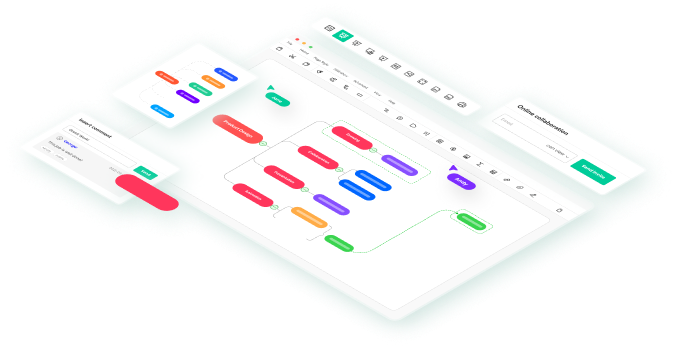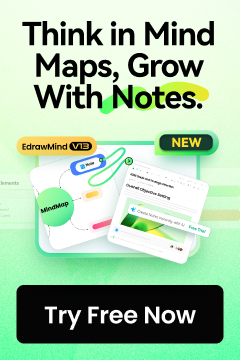Founded in 1998, Google has become the world’s leading technology and internet services provider. It revolutionized how people access information, connect, and work.
From its search engine to cloud services and AI, Google has shaped the digital era. Its mission, vision, and values highlight accessibility, innovation, and responsibility. These guiding principles explain how Google balances global growth with ethical impact.
Using EdrawMind, these elements can be visualized in structured diagrams for analysis.
In this article
Company Overview of Google
Google started as a research project by Larry Page and Sergey Brin at Stanford University. Today, it’s one of the most influential companies under its parent Alphabet Inc. Google is best known for search, ads, Android, YouTube, and cloud services.
Here’s a quick overview of Google.
| Aspect | Information |
| Founded | 1998 |
| Headquarters | Mountain View, California, USA |
| Products | Search, Gmail, Google Maps, YouTube, Android, Google Cloud, Pixel devices |
| Market Reach | Over 200 countries worldwide |
| Industry | Technology, Internet, Software, AI |
| Brands | Google Search, YouTube, Google Maps, Google Cloud, Android, Pixel |
| Key Focus | Information access, innovation, AI leadership, digital platforms |
| Corporate Strategy | Diversification, R&D investment, user-first approach |
| Revenue | $370+ Billion |
| Official Website | https://www.google.com/ |
This overview shows Google’s influence across industries and its commitment to making information universally useful and accessible.
Google Mission and Vision Statement Analysis
Google’s mission and vision form the core of its brand. Both emphasize knowledge, accessibility, and technological progress. These statements guide its products and services that billions of people use daily.
Here’s a mind map created in Wondershare EdrawMind. See how the diagram organizes Google’s mission, vision, and values into a clear framework.
Google Mission Statement
Google’s mission is:
“To organize the world’s information and make it universally accessible and useful.”
The mission highlights accessibility and knowledge sharing. Google ensures that everyone, regardless of background, can access reliable information. Its services, from Search to Translate, reflect this commitment.
Another theme is usefulness. Beyond access, Google focuses on tools that add value to people’s lives. Gmail improves communication, Google Maps guides navigation, and Google Scholar advances research. Every product contributes to making knowledge practical and helpful.
Continuous improvement is also part of the mission. By integrating AI and machine learning, Google ensures its services remain fast, accurate, and relevant. This aligns with the company’s role as a global information provider.
Google Vision Statement
Google’s vision is:
“To provide access to the world’s information in one click.”
This vision expands on its mission by focusing on speed and simplicity. The phrase “one click” represents efficiency and ease of use. Google wants to remove barriers between people and the information they need.
The vision also emphasizes global reach. Whether through Search, YouTube, or Android, Google strives to impact billions of users worldwide. Accessibility is not limited to geography. It includes language, devices, and digital literacy.
Distinctiveness is another focus. Google seeks to innovate in ways that only Google can. By combining data, AI, and design, it provides unique user experiences that set new industry standards.
Google Core Values
Google’s core values support its innovation-driven mission:
- User Focus: Always prioritize user needs in product design.
- Excellence Through Speed: Deliver results quickly and accurately.
- Innovation: Encourage creativity, experimentation, and bold ideas.
- Transparency and Integrity: Build trust through openness and accountability.
- Diversity and Inclusion: Value different perspectives and voices.
- Sustainability: Support environmental and community responsibility.
These values ensure that Google’s growth is balanced with responsibility. They help maintain public trust while pushing forward technology and global influence.
How To Analyze Google’s Mission and Vision Statements
Google’s mission and vision highlight accessibility and knowledge. The mission focuses on organizing information, while the vision emphasizes speed and simplicity. Together, they guide how Google builds products that remain useful and approachable to people everywhere.
These statements also explain how Google connects its services. Search, Maps, YouTube, and Android all reflect the goal of making information practical. This consistency helps Google maintain leadership in technology and remain trusted across industries.
Responsibility is another key theme. Google uses its mission and vision to balance progress with global impact. Supporting AI, sustainability, and inclusion, it ensures innovation improves both daily life and long-term community growth.
For students and professionals, Google’s mission and vision provide lessons in purpose-driven strategy. They show that technology succeeds when it prioritizes people, not only profits. This focus creates innovation with meaning and long-lasting influence worldwide.
The next part will show you how to make a mission and vision mind map using a professional tool.
Use a Professional Mission and Vision Mind Map Maker
Turning Google’s mission and vision into visuals makes analysis easier. A mind map simplifies complex ideas, showing how principles like information, accessibility, and innovation connect. This helps students and professionals understand strategy in a clear format.
EdrawMind is the best tool for this purpose. With templates, AI features, and export options, it allows anyone to organize Google’s guiding statements. The platform saves time and creates polished diagrams for learning, research, or presentations.
Here are some standout features:

- Pre-Made Templates EdrawMind offers ready-to-use SWOT templates. For Subway, you can start with a food industry design and customize it with factors like “menu innovation” or “delivery growth.” Templates save time and improve clarity.
- AI Assistance The AI Mind Map Generator creates structured SWOT maps in seconds. By typing entries such as “franchise model,” “menu fatigue,” or “digital ordering,” users can instantly generate a full analysis.
- Collaboration Tools Teams can co-edit a Subway SWOT analysis in real time. This makes it useful for group projects, strategy meetings, and business reports. Different insights can be combined into one structured diagram.
- Cross-Platform Access EdrawMind works on desktop, mobile, and web. This makes it easy to access SWOT diagrams from anywhere. This flexibility ensures Subway’s strategy analysis stays updated across teams and projects.
- Export Options Users can export SWOT diagrams into PDF, PPT, Word, or image formats. This makes it simple to include the Subway SWOT in presentations, assignments, or strategy reports.
Steps To Make a Mission and Vision Mind Map
Creating a Google mission and vision mind map in EdrawMind takes only a few steps. The AI-powered tool helps you organize guiding statements into clear visuals. These diagrams are simple to understand and professional to present.
Follow these steps to make a mission and vision mind map using the AI Mind Map Generator:
Step 1
Download and install EdrawMind on your computer. Sign in with your Wondershare account or register a new one. Start a new project by choosing Local MindMap.

Step 2
Click the AI Mind Map Generation button from the top menu. In the pop-up, set the purpose as “Google Mission and Vision Analysis.”
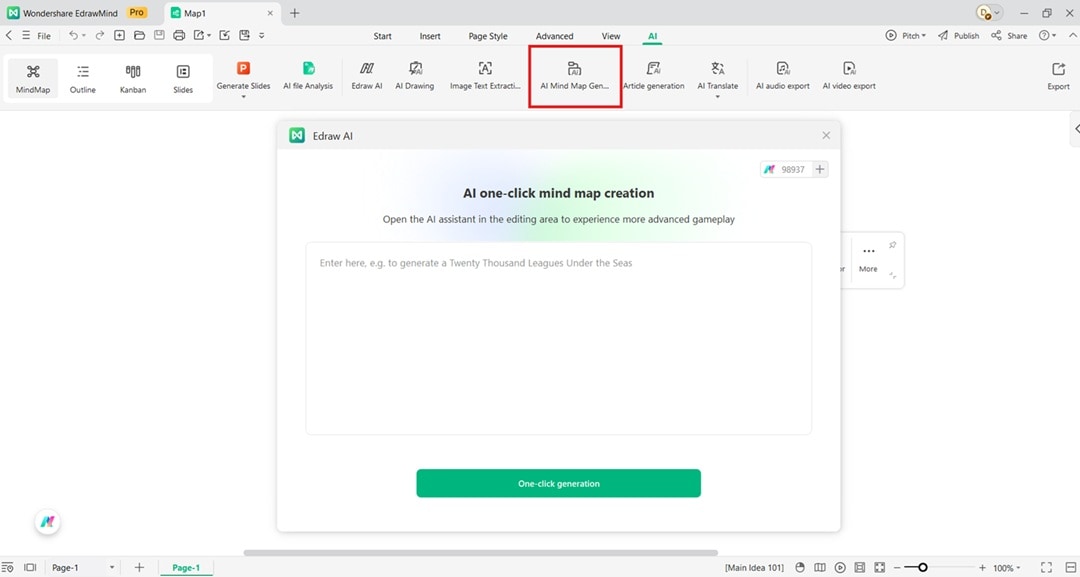
Step 3
Enter “Google Mission and Vision” in the input box. Add keywords like information, accessibility, innovation, and sustainability to help AI build stronger branches.

Step 4
Click One-click generation. Wait for EdrawMind’s AI to create branches for Google’s Mission, Vision, Core Values, and related themes.
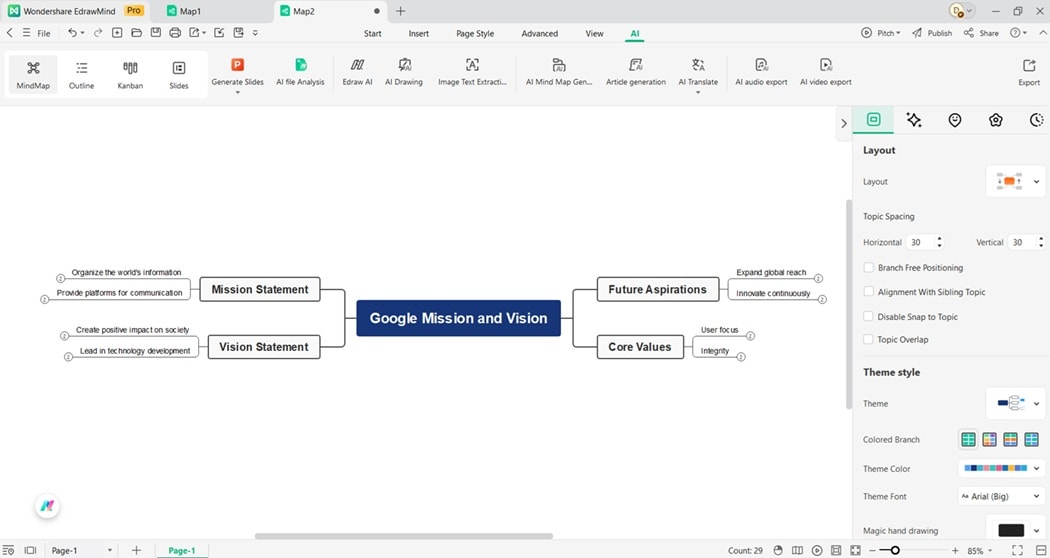
Step 5
Review the generated mind map. Add more details such as Google’s AI initiatives, sustainability efforts, and role in digital inclusion.
Step 6
Personalize the layout. Use colors, icons, and clipart to highlight sections.
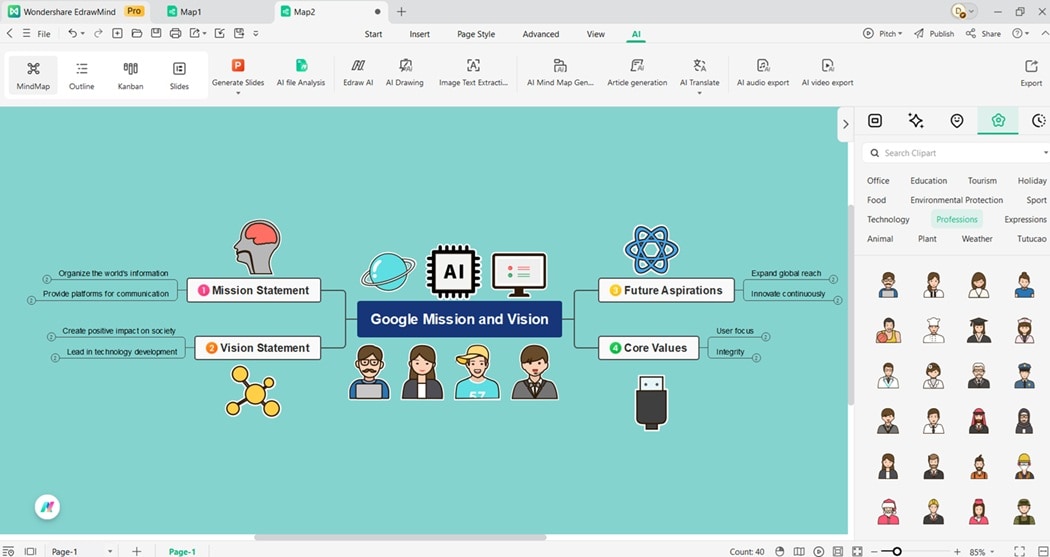
Step 7
Save the completed Google mission and vision mind map. Export it as PDF, PowerPoint, or image files to share with your audience.
Tips for Better Mission and Vision Mind Maps
Start with clarity. A Google mission and vision diagram should not be packed with long sentences. Use keywords like “accessibility,” “innovation,” and “curiosity.” This keeps ideas sharp, easy to analyze, and quick to compare.
Add variety with colors. For example, make the Mission branch blue, the Vision branch orange, and the Core Values branch green. Colors guide the eye and show the difference between each section of Google’s map.
Symbols make meaning clear. A lightbulb can mark innovation, while a globe shows global access. These visuals strengthen Google’s culture of creativity. They also keep the diagram easy to follow, even for first-time viewers.
Encourage teamwork when building the map. One member can refine Mission, another can focus on Vision, and a third can handle Core Values. Dividing roles makes the process efficient and ensures a balanced and complete analysis.
Keep the layout simple. Use clean spacing and short entries to avoid clutter. The goal is readability. A clear map highlights Google’s main principles and global strategy. Simple diagrams don’t force viewers to sort through unnecessary details.
Key Takeaways
Google’s mission and vision emphasize information access, simplicity, and innovation. These guiding principles explain how the company transforms technology. Google leverages the latest technology to create useful tools for billions worldwide.
They also highlight Google’s balance between progress and responsibility. Core values like sustainability, diversity, and transparency strengthen user trust.
With EdrawMind, these principles can be visualized in mind maps. They can be used for learning and professional analysis. This approach makes complex strategies simple, clear, and practical. Give the platform a try today to generate diagrams in seconds!
FAQS
FAQ
-
How can a mind map help analyze Google’s mission and vision?
A mind map organizes Google’s mission, vision, values, and goals into a single diagram. This visual approach makes connections clear. It simplifies complex ideas and highlights relationships that might be overlooked in plain text. -
How does Google’s vision connect to its products?
Google’s vision drives innovation in products that deliver speed, accuracy, and ease. The company aims to provide instant search results and seamless cloud services to everyone. Each tool is designed to provide users with quick access to information. -
Why are mission and vision statements important for Google?
Mission and vision statements provide direction for Google’s growth. They explain why the company exists and what it seeks to achieve. The statements show Google shaping the digital world through technology, accessibility, and innovation.



